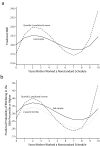Maternal nonstandard work schedules and adolescent overweight
- PMID: 18556610
- PMCID: PMC2446459
- DOI: 10.2105/AJPH.2007.123885
Maternal nonstandard work schedules and adolescent overweight
Abstract
Objectives: We investigated whether nonstandard work schedules by mothers were associated with adolescent overweight.
Methods: We conducted multiple regression analyses using a sample of mother-child pairs (n=2353) from the National Longitudinal Survey of Youth to examine the association between the number of years mothers worked at nonstandard schedules and adolescent overweight at age 13 or 14 years. Separate analyses were also conducted by family income and family type.
Results: Child's body mass index increased significantly if mothers worked either a few years or many years at nonstandard schedules. Risk of overweight was also significantly associated with 1 to 4 and 10 or more years of maternal nonstandard work schedules. In both cases, results were driven by those families with predicted incomes in the 2nd quartile ("near-poor"), with a few or many years of nonstandard work schedules also associated with increased risk of adolescent overweight in 2-parent families.
Conclusions: Results indicate the importance of the overlooked association between maternal nonstandard work schedules and adolescent overweight at age 13 or 14 years. Nonstandard work schedules among near-poor families and in 2-parent families may disrupt the work-family balance, affecting adolescent overweight.
Figures
Similar articles
-
Maternal employment, work schedules, and children's body mass index.Child Dev. 2011 Jan-Feb;82(1):66-81. doi: 10.1111/j.1467-8624.2010.01541.x. Child Dev. 2011. PMID: 21291429 Free PMC article.
-
Parental work schedules and child overweight and obesity.Int J Obes (Lond). 2012 Apr;36(4):573-80. doi: 10.1038/ijo.2011.252. Epub 2011 Dec 20. Int J Obes (Lond). 2012. PMID: 22184062
-
Mothers' nonstandard work schedules and adolescent obesity: a population-based cross-sectional study in the Tokyo metropolitan area.BMC Public Health. 2021 Jan 28;21(1):237. doi: 10.1186/s12889-021-10279-w. BMC Public Health. 2021. PMID: 33509145 Free PMC article.
-
For better or worse? Changing shift schedules and the risk of work injury among men and women.Scand J Work Environ Health. 2014 Nov;40(6):621-30. doi: 10.5271/sjweh.3454. Epub 2014 Sep 17. Scand J Work Environ Health. 2014. PMID: 25229551
-
Parents' nonstandard work schedules and child well-being: a critical review of the literature.J Prim Prev. 2014 Feb;35(1):53-73. doi: 10.1007/s10935-013-0318-z. J Prim Prev. 2014. PMID: 24014309 Review.
Cited by
-
Relationships of Maternal Employment and Work Impact with Weight-Related Behaviors and Home Environments of Mothers and Their School-Age Children.Int J Environ Res Public Health. 2023 Jul 18;20(14):6390. doi: 10.3390/ijerph20146390. Int J Environ Res Public Health. 2023. PMID: 37510622 Free PMC article.
-
Lifestyle patterns associated with diet, physical activity, body mass index and amount of recent weight loss in a sample of successful weight losers.Int J Behav Nutr Phys Act. 2012 Jun 26;9:79. doi: 10.1186/1479-5868-9-79. Int J Behav Nutr Phys Act. 2012. PMID: 22734914 Free PMC article.
-
Maternal employment, work schedules, and children's body mass index.Child Dev. 2011 Jan-Feb;82(1):66-81. doi: 10.1111/j.1467-8624.2010.01541.x. Child Dev. 2011. PMID: 21291429 Free PMC article.
-
Maternal precarious employment and child overweight/obesity in the United States.Prev Med. 2023 Apr;169:107471. doi: 10.1016/j.ypmed.2023.107471. Epub 2023 Mar 2. Prev Med. 2023. PMID: 36870570 Free PMC article.
-
Parental work characteristics and diet quality among pre-school children in dual-parent households: results from a population-based cohort in Taiwan.Public Health Nutr. 2018 Apr;21(6):1147-1155. doi: 10.1017/S1368980017003548. Epub 2017 Dec 13. Public Health Nutr. 2018. PMID: 29233206 Free PMC article.
References
-
- Anderson PM, Butcher KF. Childhood obesity: trends and potential causes. Future Child. 2006;16: 19–45. - PubMed
-
- Ogden CL, Carroll MD, Curtin LR, McDowell MA, Tabak CJ, Flegal KM. Prevalence of overweight and obesity in the united states, 1999–2004. JAMA. 2006;295:1549–1555. - PubMed
-
- Ogden CL, Flegal KM, Carroll MD, Johnson CL. Prevalence and trends in overweight among US children and adolescents, 1999–2000. JAMA. 2002;288: 1728–1732. - PubMed
-
- American Diabetes Association. Type 2 diabetes in children and adolescents. Pediatr. 2000;105: 671–680. - PubMed
-
- Mallory GB, Fiser DH, Jackson R. Sleep-associated breathing disorders in morbidly obese children and adolescents. J Pediatr. 1989;115:892–897. - PubMed
Publication types
MeSH terms
Grants and funding
LinkOut - more resources
Full Text Sources


